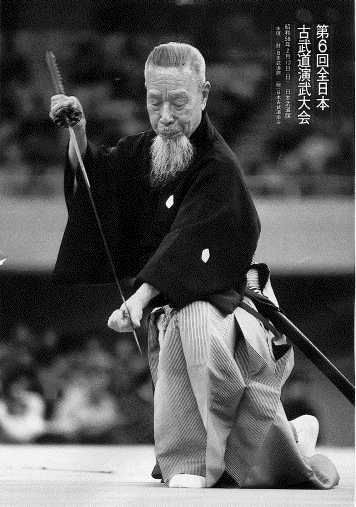|
|
|
 Iaido is the art of drawing and attacking with a sword. "Iai" is composed of the
characters "i(ru)" (to be, to stay in, to sit, to remain seated) and "a(u)" (to
come together, to meet, to harmonize). There is some debate among experts as to
how and why the term "iai" came to refer to drawing the sword. One school of
thought contends the terms originated with the practice of drawing the sword
while seated, which had no practical value in traditional times, since samurai
did not wear their long swords while seated. Another possibility is that "iai"
was adopted for this purpose to connote the idea of handling an opponent
instantly and without moving from the spot on which one is attacked.
Iaido is the art of drawing and attacking with a sword. "Iai" is composed of the
characters "i(ru)" (to be, to stay in, to sit, to remain seated) and "a(u)" (to
come together, to meet, to harmonize). There is some debate among experts as to
how and why the term "iai" came to refer to drawing the sword. One school of
thought contends the terms originated with the practice of drawing the sword
while seated, which had no practical value in traditional times, since samurai
did not wear their long swords while seated. Another possibility is that "iai"
was adopted for this purpose to connote the idea of handling an opponent
instantly and without moving from the spot on which one is attacked.
Iaidoka (and kendoka) wield a sword not to control their opponent, but to control themselves. Iaido is mostly performed solo as a series of kata, executing varied techniques against single or multiple imaginary opponents. Each kata begins and ends with the sword sheathed. In addition to sword technique, it requires imagination and concentration in order to maintain the feeling of a real fight and to keep the kata fresh. Iaidoka are often recommended to practice kendo to preserve that fighting feel; it is common for high ranking kendoka to hold high rank in iaido and vice versa.
In order to properly perform the kata, iaidoka also learn posture and movement, grip and swing. Sometimes iaidoka will practice partner kata similar to kendo or kenjutsu kata. Unlike kendo, iaido is never practised in a free-sparring manner.
Iaijutsu is the art of killing on the draw. Iaijutsu teaches how to draw quickly and in such a fashion as to negate an opponents attack with finality.
Seitei-gata iaido (that set of techniques recommended by the ZNKR) is like a moving meditation - the draw and cut are very deliberate, formalized and beautiful. It is as far removed from iai-jutsu as kendo is from kenjutsu. Iaijutsu is more direct and forceful, less concerned with the state of the practitioner's mind and more with dispatching the opponent.
Having said that, iaido schools are generally affiliated with a particular ryu of iaido. In addition to the seitei-gata, students also learn their own ryu's techniques, which may be close to the seitei-gata in feeling or close to what is described here as iaijutsu. It's not completely black and white.
Iai is like karate, it is a broad "method of combat" which involves drawing and cutting like karate involves kicking and punching. The various styles are just that, styles. The main thrust stays constant.
The only (legitimate) ryu that usually calls itself iaijutsu that the author knows of is the Tenshin Shoden Katori Shinto Ryu. Katori Shinto Ryu is a bujutsu ryu, meaning many types of armed and unarmed combat are taught. Most other so-called iaijutsu schools are run by charlatans.
Two of the oldest iaido ryu extant today are Tatsumi Ryu and Shindo Munen Ryu. The other ryu listed here, and most of the ryu practiced today come from a common root, the Muso Ryu of Hayashizaki Jinsuke Shigenobu. These include Sekiguchi Ryu, Hoki Ryu, Tamiya Ryu, Jushin Ryu, Suio Ryu and Ichinomiya Ryu.
The most popular (in terms of numbers of students) forms of iaido are represented by the Muso Jikiden Eishin Ryu and the Muso Shinden Ryu. The iaido of the ZNKR is heavily based on these two schools, that of the ZNIR (Zen-Nippon Iaido Renmei, the All-Japan Iaido Federation) mostly based on the former. Most modern students belong to one of the two ryu, plus the ZNKR or ZNIR.
Toyama Ryu and Dai Nihon Batto Ho are offshoots of Muso Jikiden Eishin Ryu, although Toyama Ryu is actually just a subset.
There are many other ryu, especially in Japan. This has been a partial listing of the most popular.